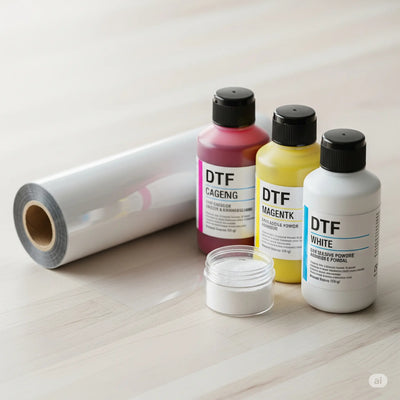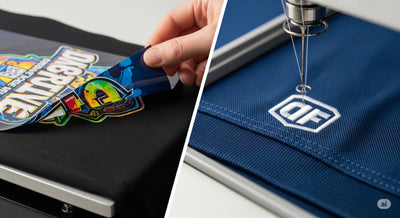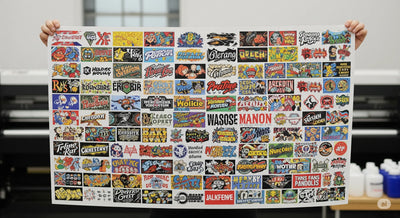

The Ultimate DTF Glossary: Key Terms for Custom Print Shops
Aug 21, 2025 (Updated on Sep 26, 2025)
Welcome to the world of Direct-to-Film (DTF) printing! Whether you're a seasoned pro expanding your services or a passionate entrepreneur just starting your custom apparel journey, you've chosen a technology that's revolutionizing the industry. But with any new venture comes a new language. From "curing" and "ganging" to "hot peel" vs. "cold peel," the terminology can feel like a lot at first.
That's why we've created the ultimate DTF glossary. This comprehensive guide is designed to be your go-to resource, demystifying the jargon and empowering you with the knowledge to print with confidence. Consider this your first step toward mastering the craft and producing incredible DTF transfers. Let's dive in!
Core DTF Materials: The Building Blocks of Your Prints
Before you can press, you need the right ingredients. These are the fundamental materials that come together to create a durable, vibrant DTF transfer. Each component, from the film it's printed on to the powder that binds it, has a specific job to do. The quality of each element is crucial, as a weakness in one can affect the entire transfer's durability and vibrancy. Let's dive into the specifics of these core components to see how they create a perfect print.
DTF Film (Transfer Film)
This is the special PET (polyethylene terephthalate) film that you print your designs onto. It's engineered to hold the ink and then release it cleanly onto the garment during the heat press process. They come in two main types:
- Hot Peel Film: Allows you to peel the film away from the garment immediately after heat pressing while it's still hot. It's a faster process, ideal for high-volume jobs. The resulting print often has a softer hand feel and a more matte finish, integrating seamlessly into the fabric. The key is to peel it quickly and confidently in one smooth motion to ensure a clean release without pulling up any of the design.
- Cold Peel Film: Requires you to wait until the transfer and garment have cooled down completely before peeling. This often results in a glossier finish and can be more forgiving for intricate designs. This waiting period allows the adhesive to fully solidify and create a stronger bond with the fabric, which is why it's excellent for fine lines and small text. While it takes more time, this method provides a higher success rate for beginners, as there's less risk of accidentally lifting parts of the transfer.
DTF Ink
This isn't your standard desktop printer ink! DTF uses a specific set of water-based textile inks designed to adhere to the transfer film and then bond with fabric fibers. The standard setup is a five-color system: Cyan, Magenta, Yellow, Black (CMYK), and a crucial White ink (W). The white ink is used as an "underbase" on dark garments, ensuring the colors on top pop and remain true.
DTF Adhesive Powder (Binding Powder)
This is the magic dust of DTF! After a design is printed on the film, this finely ground thermoplastic polyurethane (TPU) powder is sprinkled over the wet ink. It sticks only to the printed areas. When melted, it creates a powerful adhesive layer that bonds the design to the fabric, giving DTF prints their signature durability and stretchability.
Essential DTF Equipment: Your Toolkit for Success
Having the right tools is just as important as having the right materials. This is the core equipment that powers the DTF printing process. Think of these as the key stations in your production line, each playing a vital role in creating a flawless final product. From the initial print to the final press, the seamless operation between these tools is what guarantees a high-quality outcome. Let's break down what each machine does and why it's essential for your success.
DTF Printer
The heart of the operation. A DTF printer is specifically designed to handle the transfer film and the unique five-color ink system. It lays down the CMYK colors first and then prints a layer of white ink on top. The quality of your printer directly impacts the detail, color accuracy, and overall vibrancy of your final product.
-
Powder Shaker & Dryer Unit
- While you can apply and melt the adhesive powder manually for small-scale jobs, a dedicated shaker/dryer automates the process. This machine evenly coats the printed film with adhesive powder, shakes off the excess, and then runs it through a heating tunnel to cure the powder, creating a ready-to-press transfer. It's a game-changer for efficiency and consistency.
-
Heat Press
- The final step in the journey. A heat press uses a combination of high temperature, firm pressure, and a set amount of time to transfer the design from the film to the garment. A quality heat press that provides even heat and pressure is non-negotiable for professional, long-lasting results.
-
RIP Software (Raster Image Processor)
- RIP software is the brain behind the printer. It's a specialized program that processes your design files (like PNGs or TIFFs) and translates them into instructions the DTF printer can understand. It's critical for managing color profiles (ensuring what you see on screen is what you get on the shirt), controlling the amount of ink used, and creating the white underbase layer automatically. Without good RIP software, achieving high-quality DTF transfers is nearly impossible.
Key DTF Concepts & Processes: Understanding the How-To
Now that you know the materials and equipment, let's look at the concepts and processes that tie it all together. This is where the true artistry and technical skill of DTF printing come into play. Each part of the process, from preparing files to the final press, plays a critical role in the quality of your finished garments. Mastering these ideas will help you achieve consistent, professional-grade results and troubleshoot any issues that arise.
-
Curing
- Curing in DTF refers to the process of melting the adhesive powder onto the printed ink. This is done in a curing oven or the dryer section of a shaker unit. The film is heated until the powder transforms from a grainy substance into a smooth, shiny, orange-peel-like texture. Proper curing is essential for a successful transfer.
-
Ganging / Gang Sheets
- This is a technique for maximizing efficiency and minimizing waste. "Ganging" involves arranging multiple designs onto a single, large DTF film. This allows you to print and press several different images—for different orders or clients—in one go. Many providers, including us here at DTF Dallas, offer the ability to build your own gang sheets, making it incredibly cost-effective for small businesses.
-
Weeding
- One of the biggest advantages of DTF is that there is no weeding! Unlike vinyl or other transfer methods where you have to manually pick out the negative space from a design, DTF only transfers the printed area. The adhesive powder only sticks to the ink, so everything else is left behind. This saves an incredible amount of time and labor, especially on complex designs.
-
Underbase
- An underbase is a layer of white ink printed beneath the colors of your design. This is absolutely essential when printing on dark or colored garments. The white base acts like a primer on a dark wall, preventing the shirt's color from dulling your design and ensuring your colors look vibrant and opaque.
-
Hand Feel
- This term describes how the print feels on the garment. DTF is known for its soft, lightweight hand feel. Because the ink bonds with the fabric rather than sitting heavily on top of it, the final print is flexible, stretchable, and comfortable to wear—a major selling point for customers.
-
Dye Migration
- This is a common issue, especially with polyester fabrics. Dye migration is when the dye from the garment "bleeds" through the print, discoloring it. For example, a white print on a red polyester shirt might turn pink over time. Using high-quality inks, powders, and proper press settings can help prevent this, and there are special "blocker" sheets and transfers for particularly stubborn fabrics.
Putting Your Knowledge Into Action
Mastering this terminology is more than just learning new words; it's the foundation for making smarter decisions, troubleshooting issues, and ultimately, growing your custom apparel business. With this glossary in your digital toolkit, you're no longer just starting out—you're speaking the language of a professional. As you move from learning to creating, remember that having a reliable partner is key. For consistently vibrant and durable DTF transfers, the team at DTF Dallas is here to support you with top-tier materials and expertise.
Whether you need premium supplies or flawless, ready-to-press transfers, we’re here to help. Explore our custom gang sheet builder and see how easy it is to bring your designs to life!
Comments 0
Be the first to leave a comment.




